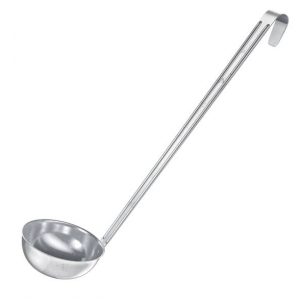Project Report For Ladle
Introduction
Project Report of Ladle is as follows.
A ladle is a serving instrument for liquid or semi-liquid foods. It is normally composed of metal and comes in a variety of sizes and shapes to suit various applications. In home kitchens, restaurants, and other food service establishments, ladles are often utilised.
A ladle’s primary function is to move liquid or semi-liquid food from a pot or skillet to a serving dish or bowl. Soups, stews, sauces, gravies, and other similar meals are frequently served in it. The form and size of the ladle might differ depending on the meal served. A large ladle, for example, can be used to serve soup, while a smaller one can be used to serve sauces or gravies.
Metal ladles, such as stainless steel or aluminium, are commonly used. They can also be covered with a nonstick coating to keep food from clinging to the surface. To protect the user’s hands from heat, the handle of a ladle is normally long and constructed of metal or a heat-resistant material, such as plastic or wood.
There are different sorts of ladles available, each with its own distinct characteristics. A gravy ladle, for example, might feature a spout for pouring sauce, whereas a soup ladle might have a circular bottom to ensure that all of the liquid is scooped up. Some ladles include a sieve in the bowl to eliminate any undesired solids.

Benefits of ladle
A ladle is a kitchen tool used to serve soup, stew, or other dishes. A standard ladle has a long handle that ends in a deep bowl, frequently with the bowl positioned at an angle to the handle to enable lifting liquid from a pot or other receptacle and transporting it to a bowl. Some ladles include a tip on the edge of the basin to enable for a finer stream of liquid while pouring; nevertheless, this might be challenging for left handed users because it is simpler to pour towards oneself. As a result, many of these ladles have pinches on both sides.
Stainless steel ladles are the most heat-resistant, making them ideal for dishing or mixing/skimming hot foods/solutions. They are resistant to stainless steel’s characteristics and are simple to sterilise.
Ladles are commonly made of the same stainless steel alloys as other cooking utensils in modern times; but, they can also be made of aluminium, silver, plastics, melamine resin, wood, bamboo, or other materials. Ladles come in a variety of sizes based on their intended usage; for example, smaller ones less than 5 inches (130 mm) in length are used for sauces or condiments, whilst extra large sizes more than 15 inches (380 mm) in length are used for soup or punch.
Get Completely Custom Bankable Project Report
Market Potential for ladle
The Indian ladle market was valued at approximately US$ 14.5 million in 2020 and is expected to grow at a compound annual growth rate (CAGR) of 8.6% from 2021 to 2028.
The foodservice segment holds the largest share of the market due to the increasing number of restaurants, cafes, and other foodservice establishments. However, the household segment is also expected to grow at a significant rate due to the rising awareness about healthy eating and the growing trend of home cooking.
Due to increased consumer spending patterns, rising per capita income, and expanding populations in various regions of the state, the India household cooking appliance market has been expanding consistently in recent years and is anticipated to expand by double digits in the next years.
The Indian kitchen is seeing an increase in demand for branded products from rural areas as a result of rural people’s increased awareness of greater quality and durability. It is one of the primary variables influencing the market for household cooking appliances in India.
Due to the growing competition between physical retailers and the general public spending more time online, it is anticipated that online sales of these devices will continue to grow in the future. Consumers are still more likely to pick this channel than traditional in-store purchasing thanks to the simplicity of financing offered by e-commerce behemoths like Flipkart and Amazon and the numerous online discounts available. All consumers now primarily purchase goods on the internet.

